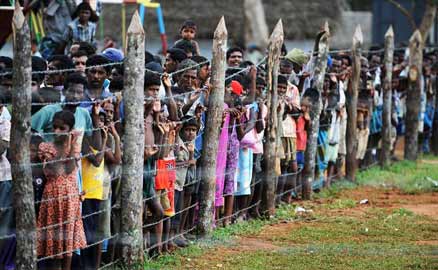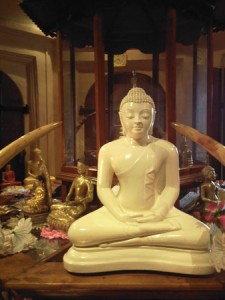The Tamil Tigers and the Tooth of the Buddha

Tamil refugees
by Kaye Thomson
The brutal civil war in Sri Lanka that raged across the island for the past twenty six years ended in defeat of the Tamil Tigers on 18th May, 2009.� Now some 300,000 Tamil civilians remain isolated in 40 detention camps in the four northern districts of the island (Trincomalee, Jaffna, Mannar and Vavuniya) awaiting an uncertain fate at the hands of the Sri Lankan government.� The international community is concerned about violations of the laws of war, including the military shelling of civilians, that paved the way to victory and the continuing intimidation by the government of the media and human rights defenders and expulsions of foreign journalists and aid workers who are deemed critical of the government.� Pleas for the release of displaced people from the camps have been ignored, creating suspicion that the government has much to hide.
Screening of persons leaving the war zone to identify Tamil Tiger combatants is expected, but international law prohibits arbitrary detention and unnecessary restrictions on freedom of movement.� Charges of criminal offense must be laid or the person released.� The Sri Lankan government is seeking international assistance to run the camps before the civilians can be returned to villages needing to be cleared of mines and rebuilt. �Many of the detainees could find themselves accommodation with family, friends or institutions in other parts of the country, but their release is denied.�
The International Monetary Fund (IMF) approved a $2.6 billion loan to Sri Lanka in July, but has not yet released the funds in quarterly installments because of concerns about the treatment of the displaced. (The United Kingdom, United States of America, Germany, France and Argentina abstained from the vote.) The United Nations has called for $270 million in aid to Sri Lanka and the Indian government has committed one million dollars in its annual budget to assist Sri Lanka in its rehabilitation and reconstruction of the northern war zone.� Meanwhile, heavy rains have caused flooding in the overcrowded camps, adding to the misery of the detainees.� Communicable diseases, such as hepatitis, diarrhea, chickenpox and dysentery have broken out in the camps, access to proper medical services is absent, sanitation facilities are inadequate, food distribution chaotic and there are shortages of water, the United Nations High Commissioner for Refugees reports.
�The world recognizes that Sri Lanka needs money to rebuild the country� said Brad Adams, the Asia Director of Human Rights Watch, �but the government�s treatment of its Tamil population in recent months has drained much of the sympathy for the challenges it faces.� The government needs to change course or expect greater international scrutiny in the future.� �A disturbing video released to the media in August shows the apparent summary execution of prisoners by Sri Lankan soldiers, prompting an enquiry into human rights abuses committed by both sides in the recent conflict.� The video was taken in January on a cell phone by a soldier, reported Journalists for Democracy in Sri Lanka to Human Rights Watch.� The Tamil editor of the North Eastern Herald Monthly in Sri Lanka, J.S. Tissainayagam, was sentenced to twenty years hard labour on 31st August for criticizing the government�s offensive against the Tamils.� President Obama picked him on World Press Freedom Day as a �symbol of oppression of the media�.
To defeat the Liberation Tigers of Tamil Eelam, who wanted to create a separate Tamil state, the Buddhist Sinhalese relied on a powerful sense of communal religious identity, embodied by the current government of Mahinda Rajapaksa and two of his brothers, Gotabhaya, the Defense Secretary and his most trusted adviser and political strategist, Basil.�
They represent the Sinhalese Buddhist population with the backing of the clergy, like the old Buddhist Kingdoms of Kandy (the northern Sri Lankan city still famous for its Temple of the Tooth of the Buddha), dedicated to ethno-national survival, unaccountable to the cabinet and parliament.�
Bradman Weerakoon, an adviser to previous Sri Lankan presidents and prime ministers, is quoted as saying that the Sinhalese are a demographic majority of twenty million with a dangerous minority complex of persecution.� They see their historical destiny in preserving Theravada Buddhism from a Hindu revivalist assault from southern India.� The Hindu Tamils, for their part, have been labeled a minority (18 per cent of the population) with a majority complex due to their ability in theory to call upon sixty million Tamils in south east India, The Sinhalese have had to deal with a vicious guerrilla insurgency with its own navy and air force and Black Tiger wing (dedicated to assassinations) suicide bombers.� The Tamils have had to deal with coercion, discrimination and the utter failure of Sinhalese government institutions to protect their communal rights.� Both sides have committed unspeakable crimes against one another, among which the Tamils are accused, during the last days of the recent conflict, of using civilians as human shields and the Sinhalese army of shelling those trapped by the fighting.�
Future peace depends now on how the government pursues its military victory.� By ignoring the international calls for restraint and restoration of freedom of speech, a new generation of Tamils in Sri Lanka, India, Europe and North America may become radicalized.� Some measure of political autonomy needs to be given to Tamil civilians to ensure that the conflict does not reignite in Sri Lanka.
© Kaye Thomson was a resident field director for World University Service of Canada in China, Malawi and Lesotho; for CUSO in Bangladesh and the Tongan Islands; and in the Ottawa office of the Canadian Public Health Association administered an HIV/AIDS programme to assist local NGOs in ten southern African countries. She is retired, lives on Vancouver Island and is now writing her memoirs.
For a detailed U.S. State Department report in the Sri Lanka situation, click here (pdf file). [Ed.]
Home

